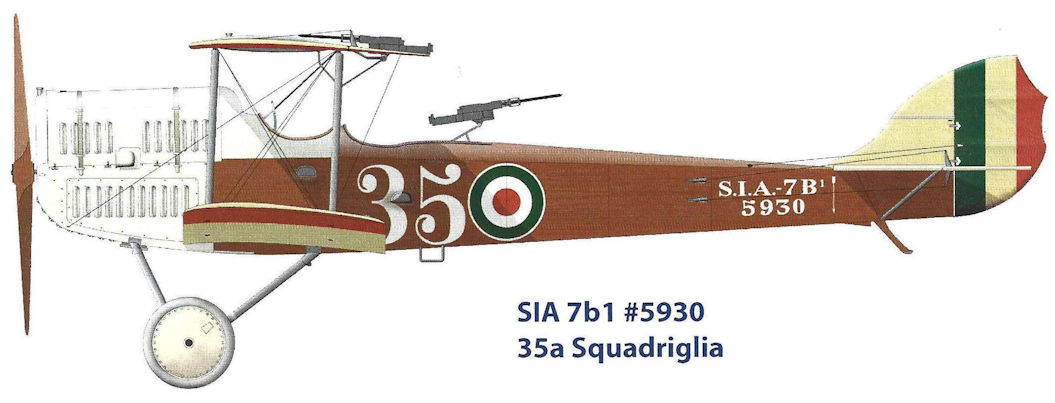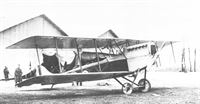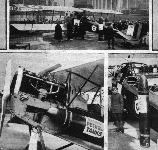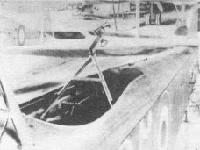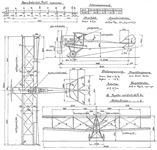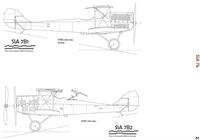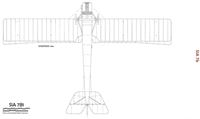В.Кондратьев Самолеты первой мировой войны
SIA.7B/7B2/9B
Цельнодеревянный двухстоечный биплан со смешанной обшивкой (фюзеляж - фанера, крылья и оперение - полотно). Спроектирован инженерами Савойя и Вердуцио на фирме SIA (Societa Italiana Aviazione - еще один авиастроительный филиал ФИАТ). Испытания прототипа начались летом 1917 г. Самолет сразу привлек к себе внимание, установив рекорд высоты полета с пассажиром и совершив беспосадочный перелет дальностью 1400 км.
В ноябре 1917-го SIA.7B принят на вооружение итальянских ВВС. Фронтовая служба выявила, помимо целого ряда достоинств, существенные недостатки машины - недостаточную прочность бипланной коробки и плохой обзор. Поэтому уже в декабре появилась модификация SIA.7B2 с усиленными крыльями, более мощным мотором и несколько приподнятыми вверх кабинами пилота и летнаба. Кроме того на ней впервые в истории авиации была предусмотрена установка подвесных топливных баков. SIA.7B2 начал поступать в разведывательные и бомбардировочные эскадрильи итало-австрийского фронта в марте 1918 года. Однако, несмотря на доработки, прочность конструкции самолета продолжала вызывать опасения. В результате, в июле 1918-го все SIA.7B и 7В2 были переведены в учебные подразделения.
В феврале 1918 года поднялся в воздух бомбардировщик SIA.9B, оснащенный наиболее мощным авиационным двигателем того периода - 700-сильным "Фиатом" A-14. Он также состоял на вооружении итальянских ВВС и принимал участие в налетах на австрийские военные объекты. Всего построен 501 SIA.7B, 71 SIA.7B2 и 62 SIA.9B.
ДВИГАТЕЛЬ
"Фиат" A-12 (260 л.с.) или A-12bis (300 л.с.) или A-14 (700 л.с.)
ВООРУЖЕНИЕ (SIA.7B)
1 тур. пулемет "Фиат-Ревелли" кал. 6.5 мм, 60 кг бомб.
ЛЕТНО-ТЕХНИЧЕСКИЕ ХАРАКТЕРИСТИКИ (SIA.7B)
S.I.A.7B, 1917г.
Размах, м 13,32
Длина, м 9,06
Высота, м 3,0
Площадь крыла, кв.м 40,0
Сухой вес, кг 750
Взлетный вес, кг 1100
Двигатель: "Фиат" A-12
мощность, л. с. 300
Скорость максимальная, км/ч 200
Время набора высоты, м/мин 2000/8,2
Дальность полета, км 550
Потолок, м 6750
Экипаж, чел. 2
Вооружение 2-3 пулемета
60 кг бомб
G.Swanborough, P.Bowers United States Military Aircraft Since 1909 (Putnam)
S.I.A. 7B
In 1917, the Italian Government sent a pair of S.I.A. 7B reconnaissance-bombers to the United States for evaluation and consideration for production under the prevailing plan to mass-produce established European designs. Developed by the Societe Italiano Aviazione of Turin, the S.I.A. 7B was powered with a 300-h.p. Fiat engine and used the standard Italian structural feature of plywood-covered fuselage. The 7B was not put into production in the U.S. but 19 were bought in Italy for use by A.E.F. units sent there.
Span, 43 ft. 8 in.; length, 29 ft. 9 in.; wing area, 460 sq. ft.; gross weight, 3,454 lb.; high speed, 111 m.p.h.
Jane's All The World Aircraft 1919
S.I.A. (Societa Italiano Aviazione).
Works at via Nizza 15, Turin. Flying ground at Lingotto. Turin. Capital paid-up: Lire 5,000,000.
This title, with its Italian-Latin word-play, must not be confounded with the pre-war firm of the same initials which produced an excellent monoplane - nor with the S.I.A.. an Aero-Club much less with the S.I.A.T. (Societa Idrovolanti Alta Italia) a Savoia offshoot.
This, the Turin S.I.A., builds a large tractor-biplane for the. F.I.A.T. engine, with which excellent heart the machine has created many records and places its ceiling some distance farther from the earth's crust than most others.
The firm's growth was abnormal - its machines were flying before the Company was constituted it is claimed - and it is now able to supply aircraft to foreign powers.
The S.I.A. biplane is a tractor type.
The upper and lower wings are united by four pairs of vertical steel struts of oval section. The upper wings are fitted with ailerons.
The fuselage is completely streamlined and consists of four longitudinal wood members with diagonal bracing and canvas covered.
The motor is a F.I.A.T. 300 h.p. 6 cylinders vertical with direct-mounted propeller, carried behind a honeycomb radiator and under a bonnet, as in automobile practice.
It has been officially announced that Lieut. Brach-Papa, Chief Pilot of the S.I.A., has created a new world's altitude record with passenger on a S.I.A. machine of the type illustrated.
This was the third height world's record won by this pilot in 1917. Lieut. Brach-Papa is one of the oldest Italian aeroplane testers. To his credit stands the flying test of more than a thousand machines of twenty different types.
The figures concerning this last record are the following, as issued in all the Italian daily papers :- Machine : S.I.A. 7.B. No. 5966. Load (Passengers and fuel): 350 kgs. (775 lbs.). 1,000 m. in 2 mins. 30 secs. 2,000 m. " 5 mins. 3,000 m. " 9 mins. 4.000 m. " 18 mins. 5,000 m. ,. 24 mins. 6,500 m. " 37 mins. 30 secs. 6,750 m. " 1 hour 3 mins. Ground level was .275 metres above the sea. Height above the sea level reached : 7,025 m. (23,000 ft.). Military Control Commission at a flying ground near Turin. Date: 14 Dec, 1917, in the afternoon.
It may be of interest to technical readers to know that the machine was tuned before starting with the " Vibration" method recently adopted by Ingegnere Lerici (See "The Aeroplane," Nov. 7th, page 1342) in order to ensure the highest safety factor to the whole structure under such abnormal conditions of flight.
THE SIA " F.B." AEROPLANE.
The S.I.A. - type F.B. biplane, which Captain Laureati flow, in lost than seven hours, from Turin to London, is associated with the following officially recorded performance :-
August 26th - The height of 20,000 ft. (6.165 m.) is reached in 34 minutes with a load of 660 lb- (comprising a pilot and a passenger).
June 28th.- The height of 24,000 ft. (7,310 m.) is reached in 56 minutes, with a load of 600 lb. (pilot alone).
August 26th. - Capt. Laureati flies from Turin to Naples and back without descending, covering in 10 hours a distance of 1,000 miles (1,400 km.).
The world's height records above-mentioned were beaten by the chief pilot of the Societa Sia, Lieut. Brach-Papa.
The motor of the SIA 7B reconnaissance-bomber of 1917 is the 250-300 h.p. Fiat "A12" motor, of the standard type widely employed in all the Italian machines.
The aeroplane was designed for being a "jack of all trades " type. Indeed, its carrying capacity, as well as its speed and climbing powers, enable it to be employed as a bomb-dropper as well as a racer.
The machine was built in the workshops for aeronautical construction of the Societa Italiana Aviazione, commonly known as the " Sin," a sister company to the famous motor-car firm, F.I.A.T.. of Turin.
The designers are the engineers, Torretta and Carlo Maurilio Lerici, of the technical staff of F.I.A.T. Co.
The initials F.I.A.T. stand for Fabbrica Italiana Automobili Torino, and the word " Fiat" in pure Latin, means " Let it Be," or " So Be it " - which, freely translated, indicates that the F.I.A.T. is undoubtedly " It." The word " Sia " in modern Italian also means " Let it be so," with a precisely similar connotation to the word "Fiat." The play on initials is ingenious.
J.Davilla Italian Aviation in the First World War. Vol.3: Aircraft M-W (A Centennial Perspective on Great War Airplanes 75)
SIA 7b1 &7b2
Fiat’s first original aircraft design (it had built M.F.11s (FSB) and S.P.3s (SIA.6b) under license) was a two-seater reconnaissance biplane equipped with a 250 hp Fiat A.12 engine. Fiat established an aviation subsidiary to produce its first design, SIA (Society Italiana Aviazione = Italian Aircraft Company). The SIA 7b, as it was designated, appeared at the beginning of the summer of 1917.
Technical
Fuselage - constructed up four longerons with plywood frames and fuselage covering. Behind the engine there was a fuel tank (95 liter) and an oil tank (50 liter). The main fuel tank (200 liters) was located between the pilot’s and gunner’s positions.
Wings - two bay wing connected by steel interplane struts. The lower wing had a slight dihedral.
Power Plant - 250/280-hp Fiat A.12
Armament - fixed machine gun on the top wing firing outside the propeller arc and controlled by the pilot. A second machine gun was mounted in the observers cockpit on a mobile mount.
Testing
SIA was anxious to build up enthusiasm for its new design. The SIA 7 could, indeed, perform well. According to Alegi, with a 500 kg payload the SIA 7b could reach 200 km/h. Climb rates included 3,000 m in 11 minutes 45 seconds and 6,165 m in 34 minutes.
Perhaps blinded by these impressive numbers and recognizing the need to replace the antiquated SAMLs and S.P.3s, an order for 300 SIA 7b on 6 June 1917.
SIA arranged for special flights to be performed to show the endurance and reliability of the new machine.
In 1917 capitano Giulio Laureati used an SIA 7b on a non-stop, round trio flight of 1,600 km covering Turin-Naples-Turin. This feat was completed on 15 August 1917 in 10 hours and 30 minutes, which constituted the world record for non-stop distance. On 24 September, 1917 an SIA 7b was also used on a 1,200 km from Turin-London in just over 6 hours, by the same pilot, but this time carrying a passenger. This set a world distance record for a flight with a passenger.
To bolster the firm’s claims, on 14 December, 1917 tenente Francesco Brach-Papa reached an altitude of 7,025 meters, beating the previous Italian height record (according to SIA).
However, these flights did not subject the aircraft to the severe stresses of aerial combat, maneuvering, and low altitude flight. Unfortunately, the DTAM (Direzione dell’Aviazione Militare = Technical Directorate of Military Aviation) did not take that fact into consideration.
Instead, it was envisioned that the SIA 7b could become the main third generation reconnaissance aircraft, replacing the older designs in most of the operational squadriglias. It was also seen as a light bomber which could fly unescorted sorties over the front. The orders for the new machine were even increased to 500 before even one could reach operational units.
Introduction to Service
While the Eleventh Battle of the Isonzo was still underway, the first two Fiat SIA 7bs were assigned to 132a Squadriglia. Results of testing by a front line unit were sent to the Comando supremo (Supreme Command) in September 1917. The performance of the aircraft was commented upon favorably, of which the speed and climbing ability were especially appreciated, and there was a clear field of vision for the observer/gunner (although the forward view of the pilot was strictly limited). The pilot fired a machine gun fitted to the top wing, outside the propeller arc; it was requested that, instead, a interrupter system should fitted. The rear gun needed a more mobile mount than the SIA design, of the type used by the French and British on the Western Front. The radiotelegraphic and photographic system, was to include two cameras with a focus of 430 mm and a supply of 24 plates for each. These were placed on the bottom of the fuselage and activated by a remote control, although the layout of the design would make this difficult in practice. The commission ended its work with a flattering evaluation of the potential of SIA.7b:
Given the aforementioned qualities of good visibility, the possibility of all installations relating to reconnaissance, significant speed ... this aircraft is considered suitable for strategic reconnaissance tactics. Due to the speed with which it is equipped, since there is no need today to provide it with the fighters for escort service, it is of essential importance to arrange an armament such as to allow combat.
The device is very well suited for observing artillery fire, ... taking advantage of all its speed which allows it to move from the target to the receiving station in a short time. Source Di Marino page 146.
It was widely recognized that the Savoia-Pomilios in Corpi d’Armata squadriglias, «(served) admirably for the artillery service for which today a fast apparatus is needed, contrary to what was thought before the recent last offensive, such that it can quickly transport the observer to the target ... and return within seconds to the radiotelegraphic station (a) report of the observation result. This is all the more necessary today due to the increased number of radiotelegraphic stations. The ... speed difference that the SIA 7b offers allows it to be able to stay on the target and make a meticulous observation.»
After the production of the first examples, the SIA 7b the designation was changed to SIA 7b1, presumably in anticipation of further developments of the design. The performance provided by the new aircraft from the first flights was truly excellent and aroused the keenest interest in military circles and seemed destined to quickly replace all other types of reconnaissance, being superior even to the best aircraft among used by the Germans and Austro-Hungarians.
It had excellent handling qualities, with a high top speed and a rapid climb rate (4,000 meters in 15 minutes). Given the mediocre, at best, qualities of the SAMLs and SP.3s still in service, the SIA.7b must have looked like the perfect aircraft to modernize the reconnaissance squadriglias. It was ordered into mass production with the initial 500 expected to be delivered in 1917/1918.
Alegi notes that on 4 October, 1917, while on a delivery flight, 5878 shed its wings in flight. The aircraft was not carrying a full combat load and was not performing aerobatics. This was the first hint that the SIA 7 series would be plagued by structural problems.
Into Service
132a’s first two SIA.7bs were returned to the manufacturer in Turin, to be modified and produced in series. It was thus hoped to have a safe and efficient airplane with which to equip the artillery squadrons and more corpi d’armati, but this hope was in vain - the SIA.7b’s design errors and manufacturing defects prevented the planned re-equipment of the army co-operation and strategic reconnaissance squadriglias. The SP.3s, which it had been intended to be replace in the first three months of 1918, would have to continue in service until the end of the war; its slow speed meaning less time over the target area to make detailed observations and substantial delays in providing photographs to the corpi and armata units which they served. In 1918 there would still be 16 squadriglias using SP.3s and four with SP.4s.
It did not take long for the consequences of that rash decision to rush to production to become evident.
(General A. A. Felice Porro, wrote in his book “La Guerra nell'Aria” (Milan 1935):
... “The need for combat and maneuvering to reach another aircraft or to escape fighters and to change altitude quickly in order to escape the area hit by the anti-aircraft fire, or to carry out strafing against the ground, subjected the structure of the aircraft to ... stresses far greater than those occurring during a normal flight regimes. The wings of the SIA 7b.1 were intolerant of these stresses and detached themselves from the fuselage, which, without any support, fell to the ground.
After these first incidents, the crews attacked by Austrian fighters, decided not to maneuver their aircraft in a fight with the opponent, and relied solely on the weapons on board, preferring to run the risk of a probable enemy attacks, instead of the certainty of death from the loss of wings.”
It is interesting to note that these comments assign no blame to the designers or workshops at SIA. It also ignores the fact that the aircraft was rushed into production at the insistence of the military.
In an attempt to rectify the situation, the SIA 7b2, a modified version of SIA 7b1 with strengthened wings, was developed. The fuselage was also redesigned to improve the pilot’s forward visibility and provide interior space so five 162-mm bombs could be carried. The standard armament was one machine gun on a flexible mount fired by the observer and a fixed gun on the upper wing that fired above the propeller disc. When they became available, a gun synchronization enabled the forward firing gun to be located in the center of the cowling.
A thousand copies of the SIA 7b2 were ordered, that number later being increased to 2,400 including examples for the United States. They began to reach front fine squadriglias in the early months of 1918, re-equipping numerous squadriglias. These units also immediately began to report difficulties with their SIAs, and it was soon decided to replace all SIA.7b1s in service with SIA 7b2s. The SIA 7b1s would, instead, be fitted with dual controls to serve as trainers.
A new design, the SIA R.2, was underway at this time. It was to have the same performance of the SIA 7b2, but with changes to make it able it to withstand the rigors of combat and improve crew safety was also built. For details see entry for Fiat R.2.
Service Use
The SIA 7b1 was in service with nine squadriglias at the end of March 1918. This model, however, was affected by problems of structural weakness which became apparent during the training. At times the wings would fail and sometimes detach themselves from the fuselage; the result was the inevitable death of the crew.
In March, the existing aircraft at the frontline units were grounded to allow the manufacturer to replace the wing attachment boxes with others with more robust fixing lugs. The lateral trusses of the engine support were also reinforced, as were the joints joining the connections of the lower wings to the fuselage.
During this work, however, the doubt arose that in carrying out the replacement, due to an imperfect connection between the attachment points of the new wing attachment boxes and the holes of the attachments fixed to the fuselage, “the workers forced., them to move to make the holes connect and introduce the pin“. (Di Martino)
These repairs could have caused a weakening of the attachment points, and therefore the recurrence of the same serious problems. There were numerous defects found as the aircraft were inspected, most were due to poor workmanship. This was not an unusual problem for the Italian aircraft industry. Certainly, British and French aircraft suffered from these types of problems, but the Italian aviation factories seem to have had exceptionally poor quality control. This was probably due to the unrealistically high production rates imposed upon SIA as the military demanded newer aircraft be sent to the front as quickly as possible.
The Comando Superiore d’Aeronautica established that all aircraft should be inspected by a commission composed of engineer captain Guidi and chief engineer Jona of the SIA company. To bolster the confidence of the unit personnel, gruppo commander, squadriglia commanders, and all the pilots were ordered to witness the verification process. Furthermore, the aircraft found to be operational after being reassembled would have been inspected and tested in flight by tenente Brach-Papa. At the end of this cycle of interventions, generale Bongiovanni would rely “on the personal influence of all the commanders because doubts about the qualities of the SIA aircraft are (to be) definitively eliminated” (Di Martino).
This was a bold, and well thought out attempt to address the problem. Sadly, it did not work. A wiser course of action would have been to cancel the production of any further aircraft. If this was done the army co-operation units would be forced to use S.P.3s and SAMLs until enough Pomilio PDs and PEs were available to replace them, but it would have reduced the number of aircrew casualties yet to come.
Problems with the SIA.7s continued to erode confidence on the SIA design.
The End
The definitive statement on the SIA’s reliability is a report cited by Alegi showed that the number of fatal crashes involving the aircraft at the Mirafiori training center were so high, that several students asked to be released to fight in the trenches! Attempts to strengthen aircraft could not improve its miserable reputation, and there was no choice but to withdraw it from operational service. In June 1918 the SIA 7b losses resulted in the realization that the aircraft was unsuitable for frontline service. The Commandante Superiore di Aeronautica (Supreme Commander of the Air Force) said that “SIA is now synonymous with misfortune”. He issued a flight ban for the type. Circular no.6120 was issued on 28 June stating that “All the SIA 7b1 and B2 single and double control aircraft will be ... by the same squadrons disassembled ...”
The nine squadriglias using the type were now deprived of their aircraft, as were the two undergoing transition training. No less than two-thirds of 3a and 4a armata’s artillery and army squadriglias had used the aircraft.
The RAF helped by supplying some RE 8s, flown by a British pilot with an Italian observer.The RE 8s operated over the Grappa and the Lower Piave. They were withdrawn beginning 11 July in the 3 armata sector (which was able to obtain some obsolescent SAMLs); the withdrawal from 4a armata took longer - until, 6 September.
24a Squadriglia was sent to the front, reformed on twelve SIA 7b with 12 pilots. Its three seziones were intended to support 3a and 4a armata and the Comando truppe altipiani (Highland Troops Command), in order to help overcome the problems of co-ordination among these forces had often led to disappointing results in 1917.
In the end, the SIA 7s suffered the ignominious fate of being burned, perhaps to help exercise the pain associated with the type.
The SIA 7s main problem was not the design, which certainly had some weaknesses, but instead the DTAM’s insistence that it be pushed into service before it could receive a proper combat evaluation. When it became clear that there were serious production problems brought on by this rushed production rate, production was allowed to continue, albeit with a series of “quick fixes” which could not eradicate all the problems. As the body count among SIA aircrew increased, the morale in SIA squadriglias dropped, even leading some crew members to refuse to fly in the machine.
In the end, may Italian reconnaissance units reverted to using the very SP.3s and SAMLs the SIAs had been intended to replace. The mediocre Pomilio PD and PE, which had its own problems, became by default the main reconnaissance type. SIA was disbanded, the name now synonymous with faulty aircraft, but was immediately reborn under the parent company’s name Fiat. Fiat would go on to built aircraft of varying quality up until nearly the end of the century.
Foreign Service
United States
The American Air Service’s Boiling Mission ordered 500 SIA 7bs in September 1917. These were to use the 240-hp Fiat A-12 engine. There are not notes on any qualitative assessment of the aircraft because its main attribute was quantitative. Fiat promised to deliver the 500 machine before the end of 1917.
In early flights in 1917, the performance of the initial version, the 7b1, was above that of similar Italian combat machines.
As the severe structural and design flaws of the type became obvious, the SIA introduced a follow on machine intended to rectify these deficiencies. As a result, the American Air Service revised its contract to 100 7b1 machines which were to be restricted to advanced training and 400 of the new and improved 7b2s for combat use.
The first SIA 7b1 for the United States were finally delivered in January 1918 to the training field at Foggia, Italy. In mid-February, 20 were shipped by rail to the training facility at Tours, France. At Foggia, they served as advanced trainers following preliminary instruction on Italian-owned Farmans. As with the experience of the Italian squadriglias, the SIA 7b1s showed they were not suitable as trainers, hardly surprising as the main complaint about the type was its fragility. Casari reports that as of March, there had been five crashes at Foggia with one death, all attributed to the plane’s defects, and Capt. Fiorello H. LaGuardia, stopped further deliveries of the 7b1 reducing the contract to 50 planes.
In the end the SIA 7b1s were almost evenly divided between Foggia (19) and Tours (25).
On 4 April 1918 the SIA 7b1 were ordered to be withdrawn and stored; their only service to the U.S. had been a three month stint as trainers for student pilots.
At least the Air Service was able to use the Fiat engines in the Breguet 14s currently being used by the U.S. Air Service.
It was proposed to strengthen the 7b1s on hand and use them as trainers for observers as the airframes would not be subjected to the depredations of student pilots; perhaps mercifully, this suggestion was not pursued.
According to Casari, the know serials at Tours were: 5850, 5851, 5868, 5879, 5881, 5903, 5905, 8203, 8244, 8248, 8255, 8259, 8268, 8271, 8274, 8276, 8282, 8291, 8292, 8303, 8342, 8343, 8393, 8802, 8804.
SIA 7b1 Two Seat Reconnaissance Aircraft with One 300-hp FIAT A.12 Engine
Wingspan, 13.32 m; length, 9.067 m; height, 2.90 m (Alegi reports 3.15); wing area, 48 sq m.
Empty weight 1,150 kg (Alegi 980); loaded weight 1,650 kg (1480); payload 500 kg
Maximum speed 175 km/h (179 km/h); climb to 1,000 m in 3 minutes 45 seconds, 2,000 m in 8 minutes 20 seconds, 3,000 m in 14 minutes; 4,000 m in 21 minutes 10 seconds, 5,000 m in 31 minutes, range 5,000 m; endurance 4 h.
SIA 7b1 Two-Seat Advanced U.S. trainer with One 240-hp Fiat A-12 Engine
Wingspan 43 ft. 8 in.; length 29 ft. 9 in.; height 10 ft. 4 in.; wing area 517 sq. ft.
Weights: Empty with water 2,357 lbs.; fuel and oil 566 lbs.; crew and equipment 535 lbs.; total 3,458 lbs.
Maximum speed at ground level 116 mph; at 6,500 ft. 110 mph.
Climb to 6,500 ft. in 8 min. 20 sec; to 13,000 ft. in 15 min. 15 sec; to 18,500 ft. in 73 min.
SIA.7b2 Two-Seat Reconnaissance Aircraft with One 300-hp FIAT A.12bis Engine
Wingspan, 13.32 m; length, 9.067 m; height 2.90 m (Alegi reports 3.15), wing area, 48 sq m.
Empty weight 1,200 kg (Alegi 1,180); loaded weight 1,710 kg (1680); payload 510 kg
Maximum speed 185 km I h; climb to 1,000 m in 6 minutes, 2,000 m in 14 minutes 20 seconds, 3,000 m in 14 minutes; 4,000 m in 39 minutes 30 seconds, range 5,000 m; endurance 4 h.
Data is from Alegi, Camurati, and Casari.
SIA 8b
A derivative of the SIA.7b fitted with a 300-hp FIAT A.12 bis engine. The fuselage, tail, and landing gear were unchanged, but the wing span was reduced. It was hoped that the smaller wings would improve the aircraft’s manoeuvrability.
The SIA.8b underwent testing in the spring of 1918, but only one was built.

